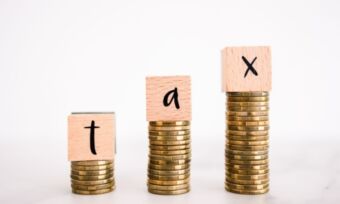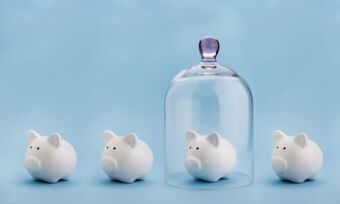Capital gains tax and shares

There are several tax considerations when it comes to buying and selling shares, with one of the most significant being capital gains tax. Director of Tax Communications at H&R Block, Mark Chapman, explores how it all works.
Are you a share investor or a share trader?
If you dabble regularly in buying and selling shares, are you a share investor or a share trader? The answer to that question will help determine how you’re taxed on any profits or losses you make on your share portfolio.
A share investor is someone who buys shares to hold onto long term, benefitting from the growth in value of the shares and the income they earn through dividends. Any profits or losses you make from selling your shares will be subject to capital gains tax (CGT), which means that profits and losses will only arise when shares are sold or otherwise disposed of. Most people who buy and sell shares are regarded as investors by the Australian Taxation Office (ATO), irrespective of how the investors see themselves.
A share trader is someone who buys and sells shares purely for short-term profits. Signs that you’re a trader can include:
- Lots of transactions
- A clear profit-making intent
- You run your activities in a business-like manner (e.g., a large investment of capital, a well-developed business plan, extensive research and properly maintained books and records).
Someone who buys and sells shares as part of a business will treat those shares as trading stock, and for tax purposes the ATO will treat gains or losses on them as ordinary income rather than capital gains.
The key tax advantage for a trader is that losses can potentially be offset against other income (subject to certain anti-avoidance provisions). For an investor, the ATO says capital losses from selling shares can only be offset against other capital gains or carried forward to offset against future capital gains, not offset against other income.
When does capital gains tax apply and how is it calculated?
When you dispose of shares, assuming you are an investor, not a trader (see above), you will normally have to pay CGT on any profits you make. Note that CGT is technically part of your income tax, rather than its own separate tax.
Typically, CGT arises when you sell shares, but it can also happen if you give them away or you stop being an Australian resident. The amount of CGT is based on any increase in value from the time the shares were acquired.
Your capital gain for a share is worked out like this:
- Deduct the cost base from the sale proceeds. The cost base is the price you paid for the share, plus incidental costs.
- Next, take away any capital losses.
- Then, discount the gain if you’re eligible. Individuals are entitled to a 50% discount. The asset must have been held for 12 months or more for the discount to be available.
- The resulting figure is your net capital gain. This is subject to tax at your marginal income tax rate.
Tip: Any shares acquired before CGT started on 20 September, 1985, are not subject to CGT.
Sometimes the proceeds and cost base of an asset are not what was actually paid and/or received for it, but rather its market value. This is typically to prevent people from minimising their tax by, say, selling the asset to a relative for a low price.
Example 1
Kerry sells some shares on the open market in March 2016 for $10,000, having acquired them in December 2005 for $5,000. She has brought forward capital losses of $2,000.
Her gain is calculated as follows:
| $ | |
|---|---|
| Sale proceeds | 10,000 |
| Cost base | (5,000) |
| Gross capital gain | 5,000 |
| Less capital losses brought forward | (2,000) |
| 3,000 | |
| Discount @50% | (1,500) |
| Net capital gain | 1,500 |
Example 2
Rather than selling the shares, Kerry gifts them to her grandchild, Ben, who of course pays nothing for them. Because the shares were gifted, they will be treated as being disposed of at market value and Kerry’s capital gains tax calculation will look exactly the same as in example 1 (above). Despite paying nothing for them, the cost base of the shares to Ben will be $10,000 (their market value).
What happens if you make a loss?
If your sale proceeds are less than your cost base, you will make a capital loss. These losses can be offset against capital gains arising in the same year and to the extent they are not used up, they can be carried forward indefinitely until capital gains arise to absorb them. Capital losses can only be offset against capital gains. They can’t be offset against any other form of income.
Tip: If you dispose of an asset during the year for a capital gain, you might want to consider disposing of any other assets you own which are sitting at a loss. That way, the capital loss can be offset against the capital gain. This is a popular year-end strategy with share investors. Be careful though, if you sell loss-making shares to crystallise a capital gain just before the end of the tax year and then buy the shares back again at the start of the new tax year. The ATO generally regards this as an artificial contrivance or deliberate tactic to generate capital losses.
How does CGT work with dividend reinvestment plans?
In some cases, shareholders may be given the opportunity to reinvest their dividends in additional shares in the paying company. If that happens, the cost base of the new shares for CGT purposes is the amount of the dividend (minus the franking credit).
Crucially, if you reinvest a dividend in this way, your income tax liability on the dividend is calculated in exactly the same way as if you’d received a cash dividend. That means you may have an income tax liability – and no cash to settle it with because the cash was all reinvested. That needs to be borne in mind as a possible outcome when you consider whether a dividend reinvestment plan is right for you.
Are international shares treated differently?
In essence, the rules for CGT on international shares are the same as for Australian ones. You’ll be liable to CGT on any shares you dispose of, and you’ll be liable to income tax on any dividends you receive. The exception is that international shares won’t have franking credits attached to them.
What happens when you inherit shares?
Inheriting shares from a deceased person does not in itself have any immediate tax consequences for you. You will not, for example, have to pay CGT until you actually dispose of the shares.
When you inherit the shares, the deemed cost at which you inherit them (which will be deducted from your proceeds when you choose to sell to give you a capital gain or loss) depends on when the deceased first acquired them:
- If the shares were acquired before 20 September, 1985, you inherit them for their market value at the deceased’s date of death. You need to hold on to the shares for at least a further 12 months in order to claim the 50% CGT discount.
- If the shares were acquired on or after 20 September, 1985, you inherit them for their original cost to the deceased (the price they originally paid). The 50% CGT discount is available to you from the date of death; there is no minimum holding period.
What records do I need to keep?
You need to keep records to substantiate your activities, the ATO says. In practice, that means you’ll need to keep your acquisition and disposal statements (your ‘buy’ and ‘sell’ contracts). Keep these records for five years from the date you dispose of your shares.
View all Canstar rated Online Share Trading products. View Disclosures.
Cover image source: Mongta Studio/Shutterstock.com
This article was reviewed by our Sub Editor Tom Letts and Sub Editor Jacqueline Belesky before it was updated, as part of our fact-checking process.

- Are you a share investor or a share trader?
- When does capital gains tax apply and how is it calculated?
- What happens if you make a loss?
- How does CGT work with dividend reinvestment plans?
- Are international shares treated differently?
- What happens when you inherit shares?
- What records do I need to keep?







